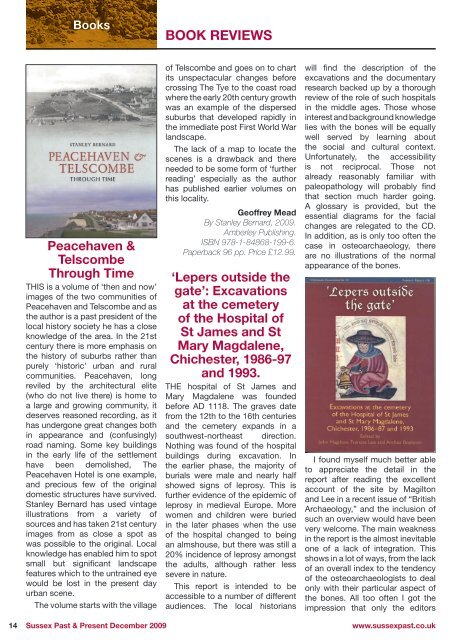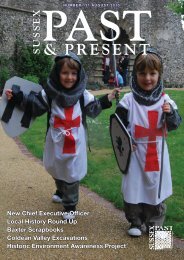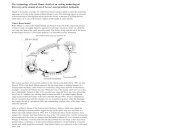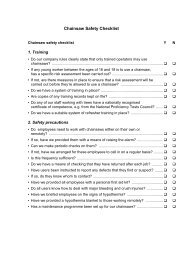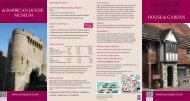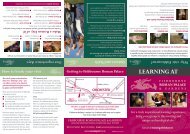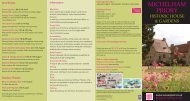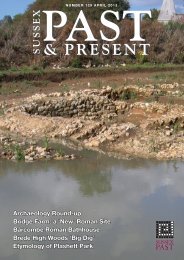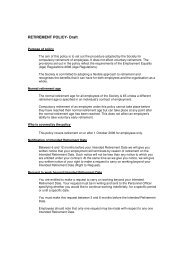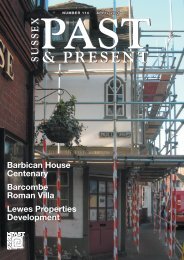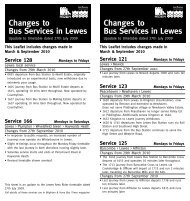December 2009 (issue 119) - The Sussex Archaeological Society
December 2009 (issue 119) - The Sussex Archaeological Society
December 2009 (issue 119) - The Sussex Archaeological Society
- No tags were found...
You also want an ePaper? Increase the reach of your titles
YUMPU automatically turns print PDFs into web optimized ePapers that Google loves.
Books<br />
BOOK REVIEWS<br />
BOOK REVIEWS<br />
Books<br />
Peacehaven &<br />
Telscombe<br />
Through Time<br />
THIS is a volume of ‘then and now’<br />
images of the two communities of<br />
Peacehaven and Telscombe and as<br />
the author is a past president of the<br />
local history society he has a close<br />
knowledge of the area. In the 21st<br />
century there is more emphasis on<br />
the history of suburbs rather than<br />
purely ‘historic’ urban and rural<br />
communities. Peacehaven, long<br />
reviled by the architectural elite<br />
(who do not live there) is home to<br />
a large and growing community, it<br />
deserves reasoned recording, as it<br />
has undergone great changes both<br />
in appearance and (confusingly)<br />
road naming. Some key buildings<br />
in the early life of the settlement<br />
have been demolished, <strong>The</strong><br />
Peacehaven Hotel is one example,<br />
and precious few of the original<br />
domestic structures have survived.<br />
Stanley Bernard has used vintage<br />
illustrations from a variety of<br />
sources and has taken 21st century<br />
images from as close a spot as<br />
was possible to the original. Local<br />
knowledge has enabled him to spot<br />
small but significant landscape<br />
features which to the untrained eye<br />
would be lost in the present day<br />
urban scene.<br />
<strong>The</strong> volume starts with the village<br />
of Telscombe and goes on to chart<br />
its unspectacular changes before<br />
crossing <strong>The</strong> Tye to the coast road<br />
where the early 20th century growth<br />
was an example of the dispersed<br />
suburbs that developed rapidly in<br />
the immediate post First World War<br />
landscape.<br />
<strong>The</strong> lack of a map to locate the<br />
scenes is a drawback and there<br />
needed to be some form of ‘further<br />
reading’ especially as the author<br />
has published earlier volumes on<br />
this locality.<br />
Geoffrey Mead<br />
By Stanley Bernard, <strong>2009</strong>.<br />
Amberley Publishing.<br />
ISBN 978-1-84868-199-6.<br />
Paperback 96 pp. Price £12.99.<br />
‘Lepers outside the<br />
gate’: Excavations<br />
at the cemetery<br />
of the Hospital of<br />
St James and St<br />
Mary Magdalene,<br />
Chichester, 1986-97<br />
and 1993.<br />
THE hospital of St James and<br />
Mary Magdalene was founded<br />
before AD 1118. <strong>The</strong> graves date<br />
from the 12th to the 16th centuries<br />
and the cemetery expands in a<br />
southwest-northeast direction.<br />
Nothing was found of the hospital<br />
buildings during excavation. In<br />
the earlier phase, the majority of<br />
burials were male and nearly half<br />
showed signs of leprosy. This is<br />
further evidence of the epidemic of<br />
leprosy in medieval Europe. More<br />
women and children were buried<br />
in the later phases when the use<br />
of the hospital changed to being<br />
an almshouse, but there was still a<br />
20% incidence of leprosy amongst<br />
the adults, although rather less<br />
severe in nature.<br />
This report is intended to be<br />
accessible to a number of different<br />
audiences. <strong>The</strong> local historians<br />
will find the description of the<br />
excavations and the documentary<br />
research backed up by a thorough<br />
review of the role of such hospitals<br />
in the middle ages. Those whose<br />
interest and background knowledge<br />
lies with the bones will be equally<br />
well served by learning about<br />
the social and cultural context.<br />
Unfortunately, the accessibility<br />
is not reciprocal. Those not<br />
already reasonably familiar with<br />
paleopathology will probably find<br />
that section much harder going.<br />
A glossary is provided, but the<br />
essential diagrams for the facial<br />
changes are relegated to the CD.<br />
In addition, as is only too often the<br />
case in osteoarchaeology, there<br />
are no illustrations of the normal<br />
appearance of the bones.<br />
I found myself much better able<br />
to appreciate the detail in the<br />
report after reading the excellent<br />
account of the site by Magilton<br />
and Lee in a recent <strong>issue</strong> of “British<br />
Archaeology,” and the inclusion of<br />
such an overview would have been<br />
very welcome. <strong>The</strong> main weakness<br />
in the report is the almost inevitable<br />
one of a lack of integration. This<br />
shows in a lot of ways, from the lack<br />
of an overall index to the tendency<br />
of the osteoarchaeologists to deal<br />
only with their particular aspect of<br />
the bones. All too often I got the<br />
impression that only the editors<br />
had read all the chapters, and their<br />
firm grasp of the overall picture<br />
comes through both in the detailed<br />
description of the cemetery by<br />
Magilton, where plots of the graves<br />
are used to effectively summarise<br />
the data and also in the final<br />
discussion by Magilton and Lee.<br />
Undoubtedly the Chichester<br />
site is an important one and the<br />
bioarchaeological data from it<br />
will continue to be analysed.<br />
In particular, because there is<br />
continuity here from a leper hospital<br />
to post-medieval almshouse it will<br />
continue to figure in the debate<br />
about the end of the leprosy<br />
epidemic in post-medieval Europe.<br />
Liz Somerville<br />
School of Life Sciences<br />
University of <strong>Sussex</strong><br />
Edited by John Magilton, Frances<br />
Lee and Anthea Boylston. Chichester<br />
Excavations Volume 10 / CBA<br />
Research Report 158. 2008<br />
ISBN 978-1-902771-72-4.<br />
Paperback, 312pp, Price £40.<br />
Hastings: Wartime<br />
Memories and<br />
Photographs<br />
THE impetus for this book came<br />
during a number of book-signing<br />
events undertaken by the author<br />
when he was approached by people<br />
who wanted to share their wartime<br />
stories with him. <strong>The</strong> result is a<br />
fascinating book devoted to 130<br />
photographs alongside the stories<br />
of 75 people, and through them a<br />
host of others who lived and died<br />
in the town during the war years.<br />
<strong>The</strong> book is divided into 7 chapters<br />
beginning with ‘<strong>The</strong> Path to War’<br />
and ending with ‘Peace Returns to<br />
Hastings.’<br />
I found this book very difficult<br />
to put down as the voices come<br />
through very clearly telling about<br />
a variety of subjects such as ARP<br />
duties, the testing of gas masks,<br />
the blackout, life as an evacuee,<br />
the fun of apple scrumping and the<br />
horrors of the air raids.<br />
<strong>The</strong> initiative of civilians in war<br />
time is well illustrated – ‘If you<br />
saw a queue, you joined it…’<br />
– as is their heroism. Several<br />
story tellers remember being<br />
thrown to the ground as children,<br />
and heroic mums lying on top of<br />
them protecting them as bullets<br />
ricocheted around them.<br />
<strong>The</strong> longest chapter is entirely<br />
devoted to recollections of air<br />
attacks. Houses looked like<br />
dolls’ houses as their fronts were<br />
blown off though several bombs<br />
penetrated buildings in such a way<br />
that they passed straight through<br />
detonating elsewhere. Eleven<br />
Canadians were killed in the Albany<br />
Hotel by a 250kg bomb which had<br />
already gone through the Queen’s<br />
Hotel without exploding.<br />
In this the 70th anniversary year<br />
of the outbreak of the 2 nd World<br />
War, it is a pleasure to recommend<br />
Nathan Dylan Goodwin’s collection.<br />
It would sit well alongside the<br />
book about Wadhurst which was<br />
reviewed in the August edition of<br />
<strong>Sussex</strong> Past & Present.<br />
Maria Gardiner<br />
By Nathan Goodman, 2008.<br />
Published by Phillimore and Co Ltd.<br />
ISBN 978-1-86077-582-6<br />
Hardback.141pp. Price £16.99<br />
Hove and Portslade<br />
Through Time<br />
HOVE, often overlooked in histories<br />
of the city, has a doughty champion<br />
in Judy Middleton, who has<br />
published a wide range of historical<br />
accounts of the former borough.<br />
In this pictorial account of Hove<br />
and Portslade she has utilised the<br />
rapid advances in digital imagery<br />
to compare and contrast old and<br />
(very) new pictures of the area with<br />
sets of ‘before and after’ views<br />
sharply delineated.<br />
As is often the case with Judy’s<br />
writings it is the inconsequential<br />
detail which is the most fascinating,<br />
in this case the number of colonels<br />
at Hove Club in 1897 caught my<br />
eye! <strong>The</strong> pictures are arranged<br />
in a general geographical order,<br />
although to someone not ‘au fait’<br />
with the topography of the area<br />
a location map would have been<br />
useful.<br />
<strong>The</strong>re seems an imbalance in<br />
the number of images of certain<br />
locations and a similar puzzling<br />
omission of some expected views.<br />
Why three views of Portslade High<br />
Street (two almost identical) but<br />
none of Hove Manor house<br />
Nothing at all of Dyke Road<br />
(or my old grammar school, now<br />
BHASVIC) or of the luxury interwar<br />
housing of Tongdean or Woodland<br />
Drive. <strong>The</strong>re are some typos in<br />
street names.<br />
This is a volume that will be pored<br />
over by both present day residents<br />
and ex-pats and is a useful addition<br />
to the canon of Hove literature.<br />
Floreat Hova!.<br />
Geoffrey Mead<br />
Convenor for Local History<br />
CCE, <strong>Sussex</strong> Institute<br />
University of <strong>Sussex</strong><br />
By Judy Middleton, <strong>2009</strong>.<br />
Published by Amberley Publishing.<br />
ISBN 978-1-84868-416-4.<br />
Paperback. 96pp, Price £12.99.<br />
14 <strong>Sussex</strong> Past & Present <strong>December</strong> <strong>2009</strong><br />
www.sussexpast.co.uk www.romansinsussex.co.uk <strong>Sussex</strong> Past & Present <strong>December</strong> <strong>2009</strong> 15


